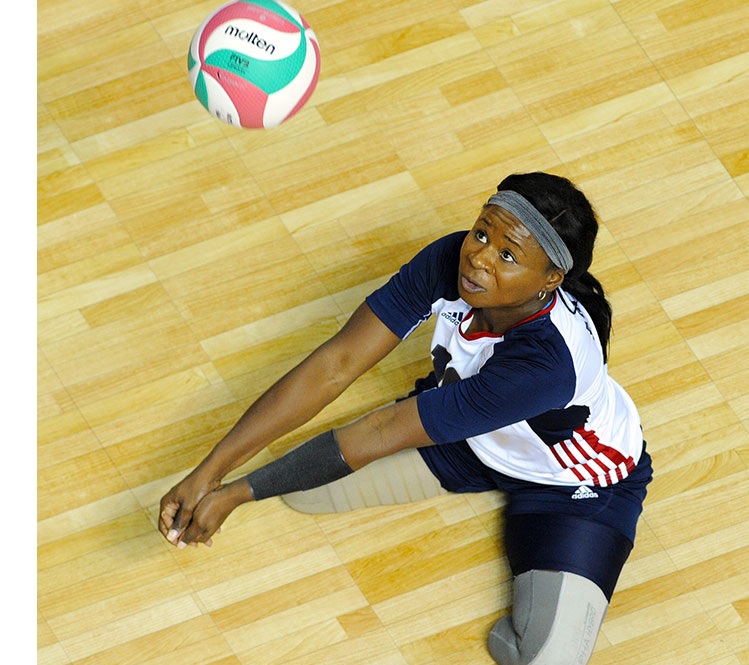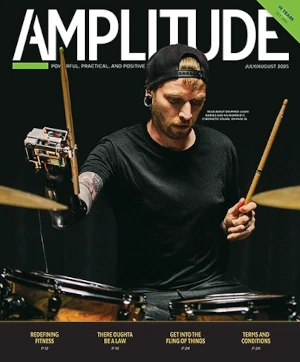
Heading home from the Rio Paralympics in 2016, Kari Miller-Ortiz felt a sense of completion and closure. She’d led Team USA to its first-ever gold medal in sitting volleyball, after runner-up finishes in 2008 and 2012. She also had helped nurture a generation of young talent that could keep the US competitive and continue to raise the overall level of play in the sport. It was a mission-accomplished moment for Miller-Ortiz, an Army veteran. She was 39 years old and ready to move on with her life. Her teammates were sad, but not surprised, when she told them she wouldn’t be back for the 2020 Games.
But, to her own great surprise, Miller-Ortiz is back—not on the court to help defend the gold medal, but in the booth as part of NBC’s broadcast team. Her new mission is to help the Paralympics gain a mainstream audience in the US, while introducing sitting volleyball to the millions of viewers who’ll be seeing it for the first time in 2021.
NBC could hardly have chosen a better ambassador. In addition to having the analytical chops to dissect the action, Miller-Ortiz has a deep passion for her sport. She can see, and describe, both its athleticism and its artistry—the bold strokes and light accents that go into the composition of each point and each match. We connected with her last week to discuss her views about educating the nation about sitting volleyball, adaptive sports, and disability in general. Our conversation is lightly edited for clarity and length.
How did NBC identify you as a candidate to join the coverage team for Tokyo?
I have no idea how they found me. I guess they reached out to the US Olympic and Paralympic Committee, and then they sent me an email and asked whether I’d be interested in doing this. There’s not very much that I’m going to say “no” to if it’s cool, so I said I’ll try—I mean, I’ve never done anything like it before, but let’s see. You have to try out for it. We did some rehearsals, and I guess they ended up liking what they heard, because they offered me the position.
When you did the rehearsals, what did you find the most difficult part of calling a game, and what parts of broadcasting just seemed to come naturally to you?
One part I found difficult is that, coming out of the military, a lot of my wording has a little bit of a military aspect. For example, I might say, “They’re really fighting for this point,” or “The match is a real war.” The feedback I got was, “They’re not fighting everything out, they’re not always battling.” I’m still working on transitioning out of that habit.
The part that came naturally is feeling the excitement of the competition. I’m seeing all my friends and people I played with, so I can be there with them because I’ve been there before. I can feel exactly what’s happening in each moment, all the emotions—from the oh-crap moments and the the hero-to-zero moments, to all the cool stuff that occurs. Having been a part of that, I can totally feel it. And I’m going to share that with rest of the world.
Do you have any thoughts, or has NBC offered any thoughts, about whether you’re calling this as a straight sporting event, versus bringing some perspective about disability and the importance of parasports in the disability community?
They’re giving me quite a bit of freedom. They want me to give a full understanding of what’s going on, and give viewers the inside scoop about these players. The US team has some of the hardest hitters in the world, so that’s part of it. Certain teams have been at the top of international competition for a long time, while others are moving up. So who is Team USA supposed to be looking out for? Those are some of things I’ll be able to share.

I also want people to understand sitting volleyball on its own terms. It’s a different game from standing volleyball. People don’t realize how fast the ball is moving. As a player, you have to be able to move [around the court] with your arms and play this super-fast ball with your arms as well. You have to be in the right place and create the right angles. One of the things I always love to say is that this is an adaptive sport, not an easier sport. People might be thinking of this as a watered-down version of regular volleyball, and it’s not. It’s a different discipline that requires amazing skill, hand-eye coordination, super-fast reflexes, and court awareness.
There’s a certain beauty in it if the match is going correctly. It’s almost like a dance. When one side is on the attack, and you see the everyone on the defense pull up a little bit, with the head people up at the net blocking and other people moving forward to cover—once you understand the physicality and the mental aspects of what’s going on, it can be a very beautiful game to watch.
When you’re describing these athletes as powerful hitters with fast reflexes, and you talk about the gracefulness in the sport—these are attributes that are not naturally associated with people who have disabilities, at least in the United States. Is part of the objective to help redefine disability?
This may be an unpopular position to take in this day and age, but we’ve always placed adaptive sports in this public-interest arena. And I don’t know how fair it is that every time we get a piece of the spotlight, it has to be about [disability] instead of just being about the game itself. I’m not against that, but it’s not going to be my primary goal. My primary goal is for people to understand the sport for what it is and to appreciate the players as athletes.
When you think back to your own introduction to parasports in the early 2000s, does that help you relate to the misunderstandings or gaps in awareness that the audience might have?
One of the first things I remember from after I got injured was a commercial. I don’t remember what commercial it was, but there was a guy skiing downhill, and he had one leg. And I was sitting there thinking, “Well that guy’s an overachiever.” Because who could really do that?
Then I was introduced to wheelchair basketball, because I’ve played basketball my whole life—basketball and track. I tried out for the US wheelchair basketball team, and I didn’t get chosen, but one of my teammates said, “Why don’t you try volleyball?” Right away, I fell in love with the fact that you could hit somebody in the face with the ball and not get in trouble. It’s been so much fun, and the journey has just been awesome. Where volleyball is now versus where it was when I started, they’re totally different games. Back then, it was just all about keeping the ball alive and not messing up. The level of play is so much better now. It has become more of what I was explaining about—more of a dance.
Did you ever think the Paralympics would reach the point where they’d get the kind of attention they’re getting this year?
I thought it was inevitable, because these are amazing sports. Like, how amazing is wheelchair basketball? You are literally playing entirely with your arms—moving all over the court, dribbling, passing, doing all kinds of magic with the ball. Or in track, you’ve got people running on stilts with springs on them. How could that not be interesting? It’s just fun to watch on so many different levels. Given the proper introduction and the proper people to share it, I always thought it would pick up a lot more followers.



